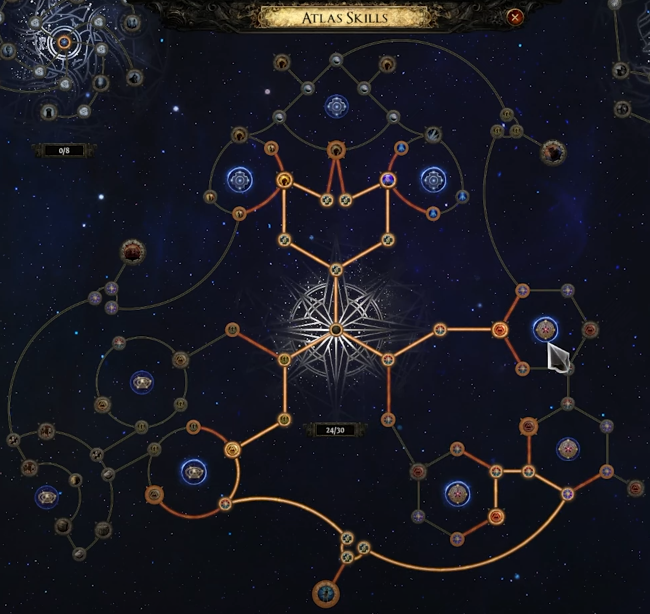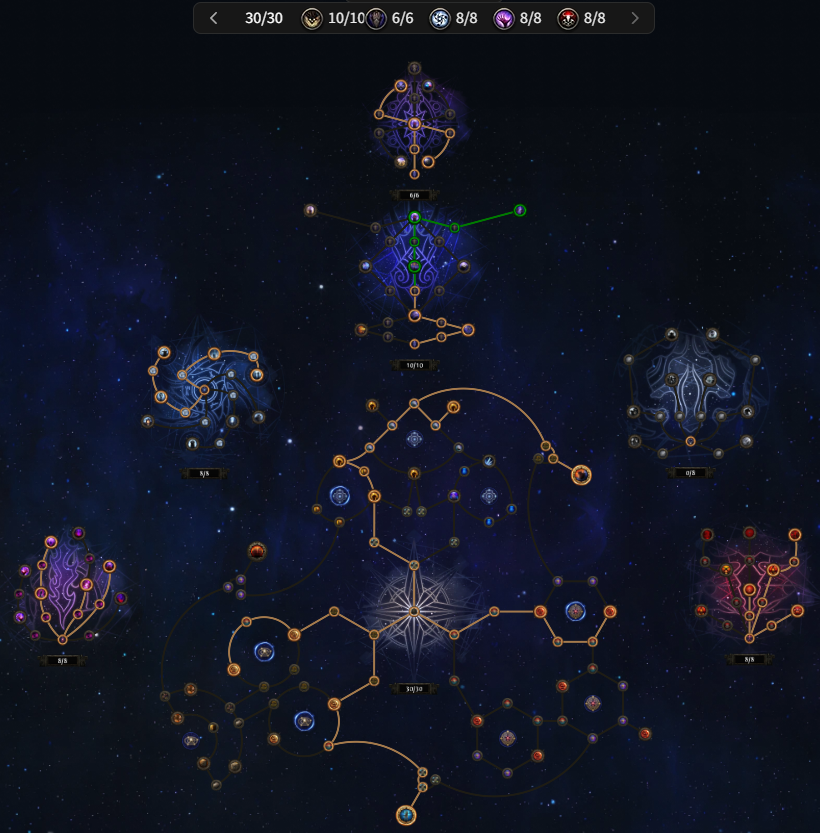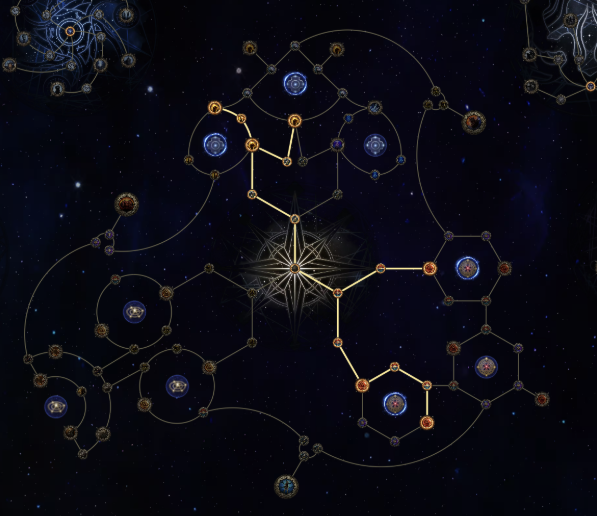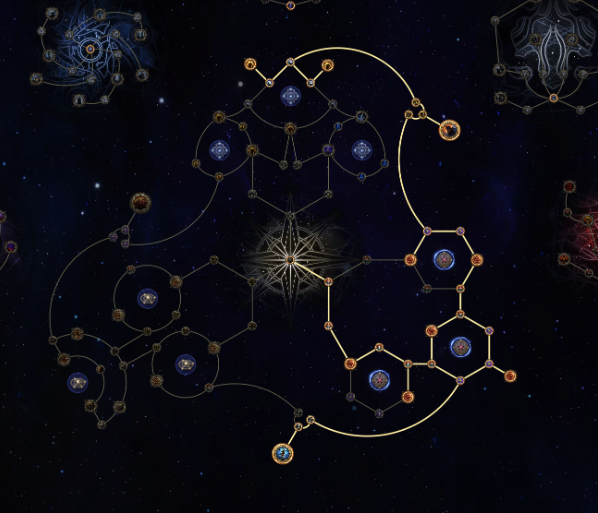Path of Exile 2 introduces a revamped endgame atlas experience, demanding new strategies and approaches to maximize efficiency and rewards. This Path of Exile 2 Atlas guide will go over the best Atlas tree strategies and how to effectively run maps to ensure your progression through the game's challenging endgame.
PoE 2 Best Atlas Passive Skill Tree Strategy Guide for Progression & Farming
The Atlas Tree is the backbone of Path of Exile 2's endgame. It allows players to customize their mapping experience by allocating points into nodes that enhance loot, increase map sustain, and modify monster encounters. Every player’s Atlas will start from a central node and branch outward, offering unique nodes to specialize in various aspects of mapping, such as rare monster farming, league mechanics, or boss encounters.
PoE 2 Atlas Tree Fast Unlock:
The Atlas Tree is unlocked after completing the campaign and is accessible via Ctrl + U. It allows you to allocate skill points earned by completing maps of higher tiers. Early on, your focus should be on:
Sustaining maps: Ensuring you always have maps to run.
Climbing map tiers: Unlocking higher-tier maps for better rewards.
Efficient map clearing: Avoiding bottlenecks in progression.
You’ll start by completing a quest requiring 10 Tier 1 maps, gradually progressing to higher-tier maps (e.g., Tier 2. Tier 3. etc.).
Now that we understand the basics, let’s go over how to progress efficiently through the Atlas and maximize your rewards.
PoE 2 Best Atlas Progression Strategy (Early Endgame)
Once you’ve completed the campaign and unlocked mapping, your immediate goal is to begin progressing through the Atlas. Early on, you'll focus on sustaining maps, increasing your map tier, and unlocking Atlas passive points.
1. Buy and Sustain Maps:
Start by purchasing Tier 1 maps from the vendor, Doryani. He provides a steady supply of low-tier maps, which are essential for kickstarting your Atlas progression. Utilize the reforging bench in your hideout to combine three maps of the same tier into one map of a higher tier. This helps maintain a steady supply of higher-tier maps as you climb the tiers.
2. Use Precursor Tablets:
Precursor tablets are powerful tools that modify maps. Look for tablets with the "Irradiate" or "Corruption" modifiers, as these increase the area level of maps by +1 or +2. improving your chances of dropping higher-tier maps. Socket these tablets into towers on the Atlas to apply their effects to surrounding maps.
3. Focus on Key Atlas Nodes:
Early on, invest in Atlas nodes that help sustain maps. Nodes that grant a chance for maps to drop one tier higher or increase the quantity of maps dropped are invaluable. Aim for nodes like "20% Chance to Drop a Tier Higher" and "Quantity of Waystones Found."
4. Avoid Overjuicing Early Maps:
Avoid heavily modifying or running rare maps until your build is capable of handling tougher modifiers. Focus on completing maps efficiently and gathering Atlas points to unlock vital nodes.
By following these steps, you’ll steadily progress through the Atlas and unlock more opportunities for loot and map sustain.
PoE 2 Best Atlas Trees for Advanced Farming
Once you’ve established a foothold in the Atlas, it’s time to focus on advanced farming strategies to maximize loot and efficiency. Here are some of the best strategies:
1. PoE 2 Best Atlas Tree Strategy for Starters
Here's a breakdown of a beginner-friendly strategy to set yourself up for success:

1. First Atlas Nodes to Prioritize
Early progression can be challenging due to inconsistent map drops and a lack of higher-tier maps (Waystones). To counter this, allocate your first Atlas points as follows:
First Two Points - Invest in the node that gives a 20% chance to drop a Tier Higher Waystone from maps. This ensures a smoother progression by increasing the odds of obtaining maps from higher tiers than the ones you're running.
Next Two Points - Allocate points into 20% Increased Quantity of Waystones Found. This node increases the number of maps dropping overall, making it easier to sustain maps and progress.
2. Building a Baseline Atlas Tree
Once you’ve unlocked the initial nodes, the next step is to secure a foundational tree that supports steady progression:
Expand the "Higher Tier Waystone" Node - Continue allocating points into nodes that increase the chance of dropping higher-tier maps. Aim for a total of 50% chance to drop a Tier Higher Waystone.
Add the "Quantity" Nodes - Afterward, branch into nodes that increase the quantity of Waystones dropped in maps. While these nodes are slightly less powerful than the "Higher Tier" ones, they still contribute to map sustain.
Fill Out the Starter Tree - By the time you’ve completed these steps, you’ll have a strong baseline Atlas Tree focused on ensuring consistent map drops. This setup will allow you to climb the tiers efficiently without running out of maps.
3. Adjusting to the Challenge
As you progress to higher-tier maps (T12-T15+), the difficulty ramps up significantly. If the game feels too hard at any point, it’s okay to pause tier progression and farm maps at a tier you’re comfortable with. This allows you to improve your gear and build before tackling harder content.
4. Using Precursor Tablets for Map Sustain
While progressing through the Atlas, you’ll encounter Precursor Tablets, which can either drop white (normal) or pre-crafted (magic/rare). These tablets are crucial for boosting map sustain:
Crafting Tablets - Use crafting currency (e.g., Transmute and Augment orbs) to create Precursor Tablets with the "Increased Quantity of Waystones" prefix. This boosts the number of maps dropping in affected areas.
Socketing Tablets - Tablets are socketed into towers on the Atlas. For example, once you’ve cleared a tower, you can insert a tablet to modify surrounding maps. Look for tablets that provide "Extra Maps Dropped" or other beneficial modifiers to increase map sustain and rewards.
5. Crafting Maps for Better Drops
You can further enhance map drop chances by crafting on maps before running them. Here’s how:
Use Path of Exile 2 Currency on Maps - Transmute + Augment: Adds 2 modifiers to a white map. Regal Orb: Adds a third modifier to a blue map. Alchemy Orb: Turns a white map into a rare map with up to 4 modifiers.
Check Implicit Bonuses - Some maps already have implicit bonuses like "100% Increased Waystone Drop Chance." Crafting these maps can add even more bonuses, increasing the odds of sustaining and upgrading your map pool.
2. PoE 2 Best Atlas Tree Strategy for Currency & Loot Farming
As you progress deeper into the Path of Exile 2 endgame, your Atlas Tree strategy becomes more nuanced. Beyond sustaining maps, the goal shifts towards maximizing loot, currency acquisition, and taking full advantage of advanced mechanics like modifiers, rare monsters, and precursor tablets. Here we outline an advanced strategy to help you navigate the Atlas effectively and optimize your endgame experience.
1. Focus on Sustaining Maps (Waystone Drops)
Sustaining maps remains a top priority, even at advanced stages. However, the focus shifts to improving map quality and drop rates by leveraging Atlas nodes and crafting methods:
Crafting Waystones - Always run maps as blue (magic) or rare to increase the chances of monsters dropping additional Waystones. Use Transmutation Orbs and Augmentation Orbs to craft blue maps early, and switch to Regals or Alchemy Orbs for rare maps as resources become available.
Atlas Nodes for Waystone Sustain - Prioritize nodes like: "High Road" (20% Chance to Drop a Tier Higher Waystone), "Quantity of Waystones Found". These nodes remain critical for maintaining a steady supply of higher-tier maps while farming.
Monster Density for More Drops - Invest in nodes that increase the number of monsters in maps, such as "Increased Monster Pack Size". This indirectly boosts map sustain by providing more opportunities for Waystones to drop.
2. Leverage Precursor Tablets to Juice Maps
Precursor tablets are essential for advanced progression, enabling you to heavily modify maps for better rewards. Here’s how to use them effectively:
Crafting Precursor Tablets - Use crafting currency to add modifiers that benefit map sustain and loot. Look for: "Rare Monsters Have Additional Modifiers", "Increased Quantity of Waystones Found", "Maps in Range Become Irradiated" (Increases Monster Level by +1)
Socketing Precursor Tablets into Towers - Place tablets in towers to apply their effects to nearby maps. For example: Socket tablets with "Irradiate" to increase monster levels in surrounding maps, which boosts loot quality and map drops. Combine "Corruption" and "Irradiate" for even higher monster levels, but be ready for tougher fights.
Juicing Maps with Multiple Mechanics - Use tablets to stack multiple modifiers on maps, such as Breach, Ritual, and Delirium. These mechanics increase density and reward potential but require builds capable of handling the difficulty.
3. Target Rare Monster Nodes (Deadly Evolution)
Rare monsters are the lifeblood of loot in Path of Exile 2. and advanced strategies revolve around farming them effectively.
Invest in Deadly Evolution - Allocate points into the "Deadly Evolution" node, which grants rare monsters additional modifiers. More modifiers mean higher drop rates for loot, currency, and Waystones. This node also applies to unique monsters, such as map bosses, making them significantly more rewarding.
Rare Monster Duplication - Pick nodes that increase the number of rare monsters in maps or duplicate rare monsters. Doubling rares essentially doubles your loot potential and map sustain.
4. Optimize for Wealth Acquisition
At this stage, you should focus on maximizing your currency and item drops to fuel your build and further progression.
Quantity and Rarity Nodes - "Quantity of Items Found in Maps", "Rarity of Items Dropped by Monsters". These nodes enhance overall loot quality and quantity, ensuring valuable rewards.
Biome-Specific Nodes (Local Knowledge) - Certain nodes increase drops based on map biomes: Swamp/Water Biomes (Higher chance of basic currency drops), Mountain Biomes (Increased gold drops), Forest Biomes (Better jewel drops). Use these to tailor farming based on your needs.
5. Advanced Crafting and Map Rolling
Crafting maps and managing modifiers is critical for maximizing rewards at higher tiers:
Roll Maps for Better Modifiers - Use Alchemy Orbs to make maps rare and add up to 4 modifiers. Look for modifiers that increase monster density, pack size, or Waystone drop chance. Avoid overly dangerous modifiers unless your build is capable of handling them.
Reforge Lower-Tier Maps - Use the Reforging Bench in your hideout to combine 3 maps of the same tier into one map of a higher tier. This is an efficient way to upgrade lower-tier maps you no longer need.
6. Specialize in League Mechanics
League mechanics like Breach, Ritual, and Expedition offer massive loot potential when combined with Atlas nodes.
Breach - Nodes that increase Breach monster density and splinter drops are highly rewarding. Breaches spawn a high density of rare monsters, making this mechanic ideal for currency farming.
Ritual - Allocate points into Ritual nodes to increase tribute and rewards. Ritual rewards often include valuable crafting materials and unique items in Path of Exile 2.
Expedition - Target nodes that add rare monsters and increase artifact drops.
Expedition mechanics are great for acquiring crafting currency and logbooks.
7. Plan Around Map Layouts and Bosses
Map layouts and bosses play a significant role in farming efficiency and loot potential:
Boss-Oriented Farming - Nodes that increase boss loot or guarantee higher-tier Waystone drops from bosses are excellent choices. These nodes make bosses a reliable source of map sustain and valuable drops.
Avoid Poor Layouts - Skip maps with layouts that are difficult to navigate or slow to clear. Efficiency is key in advanced farming.
8. Adapt Your Tree Over Time
The Atlas Tree is highly flexible, and respecs are cheap (around 5.000 gold per node). This allows you to adjust your tree based on your current goals:
Early Focus: Sustain maps and increase loot quantity.
Mid-Game: Invest in rare monster nodes and league mechanic specialization.
Late Game: Juice maps heavily with tablets and modifiers while specializing in specific farming strategies.
3. PoE 2 Atlas Tree for Target-Specific Farming
The Atlas Tree offers numerous ways to maximize loot, increase monster density, and specialize in mechanics to target specific rewards. This guide outlines advanced strategies to get the most out of your Atlas Tree for farming.

1. Prioritize Map Sustain and Waystone Quantity
Maintaining a steady supply of maps is critical for farming higher tiers consistently. Start by ensuring your Atlas Tree supports map sustain:
Key Nodes to Start - "20% Quantity of Waystones Found in Maps": Increases overall map drops. "Chance for Waystones to Drop a Tier Higher": Prioritize these small nodes to smooth your progression into higher-tier maps.
Once these foundational nodes are allocated, focus on other aspects of map sustain, such as: Precursor Tablet Efficiency: Nodes that enhance Precursor Tablets (e.g., double effect of modifiers) can drastically improve map drops and monster density.
You ensure a continuous farming loop by building a strong foundation for map sustain.
2. Focus on Rare Monsters for Loot
Rare monsters are the single most lucrative source of loot in maps. Advanced Atlas strategies leverage this by increasing the number and quality of rare monsters in your maps:
Rare Monster Nodes:
- "Increased Rare Monster Density": Adds more rare monsters to maps.
- "Rare Monsters Are Duplicated": Effectively doubles your loot from rares.
- "Deadly Evolution": Grants rare monsters additional modifiers, further increasing their loot potential.
Why Rare Monsters Matter - Rare monsters drop significantly more loot than normal mobs. By investing in nodes that boost rare monster density and modifiers, you increase your chances of obtaining valuable currency, crafting materials, and Waystones.
3. Specialize in League Mechanics
League mechanics offer some of the best opportunities for advanced farming. These mechanics add extra density and unique loot to your maps. Here’s how to optimize your Atlas Tree for specific mechanics:
Breach (Top Priority) - Breach is widely regarded as one of the most rewarding mechanics due to its high monster density and raw currency drops.
Key Nodes:
- "75% Increased Quantity of Breach Splinters Dropped by Monsters"
- "Increased Breach Monster Density"
- "Breach Opens and Closes Faster": Once your build is strong, this node saves time while maintaining loot efficiency.
Why Breach is Great: Breach spawns a huge number of monsters, many of which are rares, and generates splinters for Breachstones (used for valuable boss fights).
Expedition - Expedition is another top mechanic for farming currency and crafting materials.
Key Nodes:
- "Number of Rare Expedition Monsters in Maps": More rares = more loot.
- "Increased Quantity of Expedition Artifacts": Boosts your crafting currency acquisition.
- "Increased Chance to Drop Logbooks": Logbooks are the most valuable Expedition rewards.
Why Expedition is Great: Expedition combines dense packs with high-value crafting materials, making it perfect for wealth generation.
Other Mechanics (Optional):
Ritual: Rewarded with tribute points that can purchase valuable items. Focus on nodes that increase Omen drops and additional rituals in maps.
Delirium: While less impactful than others, Delirium can yield unique crafting materials for amulets or high-value loot when stacked heavily.
4. Use Precursor Tablets to Juice Maps
Precursor Tablets play a vital role in advanced farming by modifying maps to increase density, difficulty, and rewards.
Key Strategies:
Use tablets with "Irradiate" and "Corruption" modifiers to boost monster levels by +1 or +2. Higher monster levels improve loot quality and map drops.
Look for tablets that add league mechanics, such as Breach or Ritual, to stack multiple rewarding mechanics in a single map.
Combine tablets with Atlas nodes that enhance their effects (e.g., double effect of Precursor Tablets).
Tip: When socketing tablets into towers, prioritize areas with high-value maps or league mechanics. This ensures you maximize the rewards for your effort.
5. Invest in High-Risk, High-Reward Modifiers Late Game
As your build becomes stronger, you can allocate points into nodes that increase map difficulty but also enhance rewards. These nodes are best saved for late-game farming when your character can handle tougher content.
Key Nodes:
- "25% More Effective Prefixes/Suffixes on Maps": Increases the power of map modifiers, which boosts both difficulty and rewards.
- "Double Effect of Precursor Tablets": Amplifies map density and loot.
- "Corruption and Radiated Maps": Adds +1 or +2 monster levels, increasing both loot and map drops.
Why These Work: High-risk modifiers significantly increase loot quality and quantity, making them ideal for advanced farming. However, they require a solid build capable of handling tougher enemies and map bosses.
6. Boss-Oriented Farming
Once you’ve established consistent map sustain and loot efficiency, consider specializing in boss farming:
Boss Nodes:
- "Increased Rarity and Quantity of Items Dropped by Map Bosses": Makes bosses a reliable source of loot and Waystones.
- "Unique Bosses Drop Additional Maps": Helps sustain high-tier maps.
- "Rare Monsters Have Additional Modifiers": Boosts loot from both bosses and other rare enemies.
Why Focus on Bosses: Bosses in high-tier maps can drop unique items, crafting materials, and high-tier Waystones. With the right Atlas nodes, they become a lucrative farming target.
7. Map Layouts and Efficiency
Not all maps are created equal. For advanced farming, prioritize maps with:
Easy-to-Navigate Layouts: Avoid maps with confusing or time-consuming layouts.
High Monster Density: Maps with dense packs are more efficient for farming currency and loot.
Skip maps that are poorly suited for your build or lack rewarding mechanics.
8. Adapt and Respec When Needed
The Atlas Tree is designed to be flexible, and respecs are cheap. As your goals change (e.g., farming currency, targeting bosses, or crafting), adjust your Atlas Tree accordingly:
Early game: Focus on map sustain and quantity.
Mid-game: Invest in rare monsters and league mechanics.
Late game: Specialize in juiced maps, high-risk modifiers, and boss farming.
4. PoE 2 Atlas Tree for SSF To Max Juice Maps
The Atlas Passive Tree is your gateway to shaping the endgame experience. Unlike trade leagues, SSF requires careful planning to ensure map sustain, crafting material acquisition, and efficient loot farming. The tree has three main sections and three keystones, but its layout isn’t as logically structured as it seems. Rather than sticking to one area, the key to success in SSF is cherry-picking nodes from all parts of the tree to balance your needs. Whether you’re juicing maps for loot, farming crafting resources, or sustaining high-tier maps, this guide will help you create the perfect setup.
SSF Start Atlas Tree

SSF Endgame Atlas Tree

1. Essence and Precursor Tablet Nodes
Essence Cluster
Why It’s Good for SSF:
Essences are a cornerstone of SSF crafting, offering deterministic upgrades to gear. This cluster spawns additional Essence monsters in maps, some of which drop Greater Essences (ideal for high-tier crafting).Key Nodes:
- Crystalline Growth: Improves the number of Essences dropped.
- Resonant Lettuce: Increases the quality of Essences.
Downside:
This cluster requires 5–7 points, which is a steep investment. If you already have a good stockpile of Essences, consider skipping this in favor of more loot-focused nodes.
Precursor Tablet Cluster
Why It’s Good for SSF: Tablets provide purely beneficial effects, making them a reliable source of loot and map modifiers. By investing in these nodes, you can stack effects like increased experience, item rarity, and item quantity, significantly juicing your maps.
Key Nodes:
- Precursor Influence: +30% quantity of tablets.
- Remnants of Power: 20% chance for tablets to have double effects.
- Small Nodes: +40% increased tablet effect in total.
Benefits:
These nodes allow you to maximize tablet bonuses, such as:- +20% experience gain.
- +30% item rarity or quantity.
- Rare monsters gaining additional modifiers, increasing loot quality.
Local Knowledge
Utility:
This node provides bonuses based on the biome of the map:- Mountains: Increased socket currency drops.
- Forests: Increased Jewel drops.
- Swamps and Water Maps: Basic currency drops.
Recommendation: Pair this with the Precursor Tablet nodes to supercharge your farming potential in SSF.
2. Rare Monster & Pack Size Nodes
Rare Monster Nodes
Why They’re Good for SSF: Rare monsters are a primary source of loot and crafting materials. Increasing their spawn rates directly improves your chances of acquiring high-value drops.
Key Nodes:
- Rising Danger: +15% increased rare monster spawn rate.
- Deadly Evolution: Adds 1–2 modifiers to rare and unique monsters, increasing loot potential.
Pack Size Nodes
Why They’re Essential: More monsters = more loot. Pack size nodes synergize well with rare monster nodes, making maps feel alive and rewarding.
Key Nodes:
- Teeming Horde: +10% increased number of monster packs.
- Magic Pack Size Nodes: +20% increased size of magic monster packs.
3. Map Juicing & Explicit Modifier Nodes
This section focuses on amplifying map modifiers to maximize loot. It’s designed for players with strong builds who can handle tougher maps.
Core Nodes for Juicing Maps
Constant Crossroads: +20% increased Waystones. Essential for map sustain in SSF.
Fortunate Path: +100% increased rarity of Waystones. This ensures you find magic or rare Waystones more often, saving crafting materials.
High Road: +20% chance for Waystones to drop one tier higher. Critical for sustaining high-tier maps.
Treasure Co.
Why It’s a Sleeper Node: Rare chests in maps can drop exceptionally high-value loot, often inheriting the map’s modifiers for quantity and rarity. This node is a must-try for SSF players looking to maximize loot.
Grueling Journey
Effect: +2% increased effect of explicit map modifiers per modifier.
Why It’s Good: Fully crafted maps with six modifiers gain +12% increased effects, boosting both loot and difficulty.
Enigmatic Intensification
Effect: +3% increased effect of explicit modifiers per Tower affecting the map.
Synergy: Combined with Grueling Journey, this node adds another 9% effect, compounding your juicing efforts.
Corrupted Infusion
Effect: Corrupts maps a second time for additional modifiers.
Why It’s Niche: Corrupting maps can yield powerful rewards, including additional modifiers, loot bonuses, and Waystone upgrades. However, it requires a strong build to handle potentially bricking modifiers (e.g., "Burning Ground").
4. Keystone Synergies
The keystones complement juicing strategies by further enhancing map modifiers and rare monsters.
Unstable Energies:
- Multiplies prefixes or suffixes by 25% more.
- Beneficial prefixes = more loot.
- Detrimental suffixes = increased Waystone drop rates.
Deadly Evolution: Adds additional modifiers to rares and unique. Combined with rare monster nodes, this can result in 15+ highly rewarding rare monsters per map.
Corrupted Infusion: Doubles the corruption effects on maps, further juicing rewards.





